Mobile ad hoc network is a collection of wireless mobile nodes which are capable of exchanging information dynamically among themselves without the need of any fixed infrastructure. Inorder to transfer data among these mobile nodes, the process of routing is adopted, which makes use of a routing protocol inorder to select a path along the mobile nodes in the network, through which data packets are sent. Due to dynamic nature of mobile ad hoc networks, links setup between the mobile nodes break most frequently and hence a routing protocol must be efficient enough in handling such situations and should deliver better performance in every aspect. In this paper, the performance of three routing protocols AODV, DSDV and DSR has been analysed using Network Simulator-2. Their performance is evaluated using Quantitative metrics – packet delivery ratio, average end-to-end delay, normalized routing load and jitter by varying node density and node mobility. The simulation results the routing protocol which gives better performance in various scenarios.
Keywords |
| AODV, DSDV, DSR, mobile ad hoc network, network simulator, normalized routing load, packet delivery
ratio, routing protocols. |
INTRODUCTION |
| Over past few years, wireless communication technologies has become an emerging field with large scope of research
which has undergone rapid advancements leading to Mobile Ad Hoc Networks (MANETs). Mobile Ad hoc Network
(MANET) is a collection of wireless mobile nodes that dynamically form a network without any fixed infrastructure or
support of any central administration. Since the topology of the mobile ad hoc network changes more frequently,
mobile nodes must be capable of self-organizing and self–configuring themselves. The ability of self-configuration of
these mobile nodes makes them more suitable for urgently required network connections which have numerous
applications. Such mobile ad hoc networks are basically peer-to-peer multi-hop mobile wireless networks [1], where
information packets are transmitted in a store-and-forward manner from a source to an arbitrary destination, via
intermediate nodes. Hence in MANETs, every node must be able to act as a host as well as a router to find out the
optimal path to forward a packet [2]. |
| Routing is considered fundamental in such a network due to their dynamic topology and frequent path breaks. A
number of routing protocols have been proposed so far to overcome this issue. A routing protocol specifies how nodes
communicate with each other, disseminating information that enables them to select routes between mobile nodes. A
routing protocol should be capable enough in providing minimum route acquisition delay, generating minimum control
overhead, quick route reconfiguration, loop-free routing and should be scalable [3]. In addition to these, it is the task of
the routing protocol to deliver the data packets quickly with less drop rate. In order to make the network more reliable
and perform better, the routing protocol should be efficient enough in delivering better performance in all the metrics.
The main objective of this paper is to study the performance of the routing protocols in mobile ad hoc networks against
different metrics. |
| The remaining part of this paper is organized as follows: Section 2 deals with the related work. Section 3 will give a
brief overview on routing protocols in MANETs and Section 4 gives a brief description of the simulation strategy and
simulation parameters along with the performance metrics considered in this simulation. Section 5 provides the
simulation results and a brief analysis of performance of the routing protocols selected. Section 6 will conclude this
paper. |
RELATED WORK |
| Mobile ad hoc networks has become an emerging field over past few years. A lot of research is being carried out in this
area and a number of routing protocols have been proposed and implemented for MANETs. All these protocols have
their own advantages and disadvantages under certain circumstances. A lot of simulation studies were carried out in the
papers [4], [5], [6] to review both the qualitative and quantitative properties of various routing protocols. Based upon
various observations done in [7], [8], [9] routing protocols must deal with limitations such as high error rates,
scalability, multicasting, node cooperation and must be secure and energy efficient. |
ROUTING PROTOCOLS IN MANETS |
| Routing protocols are necessary for communication in MANETs in order to target efficient and timely delivery of
message. An efficient routing algorithm should capable in providing remarkable benefits in ad hoc networks , which
includes higher throughput, lower average end-to-end delay, less number of packets dropped and generally an
ameliorated network performance [10]. Many routing protocols have been proposed so far for such networks. |
| A. Routing Protocol Classification: |
| Of the most available routing protocols, topology based routing protocols are mainly classified into three categories
– proactive routing protocols, reactive routing protocols and hybrid routing protocols. |
| 1) Proactive Routing Protocol: Proactive routing protocols are table driven protocols. These protocols are similar to
those in wired networks. In proactive routing protocols, every node maintains one or more routing tables which
contains most recent path to all nodes in the network. Various proactive protocols differ in the way in exchanging the
information about the change in topology of a network. There exists some difference between these proactive routing
protocols depending upon the routing information being updated in their routing tables. Since there is need to maintain
node entries for every node in the network, they are not suitable for large networks. This generates more overhead
which consumes more bandwidth in larger networks degrading the network performance. Examples of such routing
protocols are DSDV, OLSR. |
| 2) Reactive Routing Protocol: Reactive routing protocols are known as on-demand routing protocols. They do not
maintain any routing information or constantly update their routing tables with the latest route topology. These
protocols try to establish a connection in order to transfer data packets only when needed (on-demand). They generate
lesser communication overhead compared with proactive routing protocols. They usually flood the route request
packets through the networks in order to discover a route when needed, and the destination responds with a reply to the
request. Thus a link is established between source and destination when needed. Examples of reactive routing protocols
are AODV, DSR. |
| 3) Hybrid Routing Protocol: There is a trade off between proactive and reactive routing protocols. Proactive routing
protocols have large overhead and less latency, while reactive routing protocols have less overhead and more latency. It
inherits the merits of proactive as well as reactive routing protocols, which is considered as the combination of both the
protocols. It uses route discovery mechanism of reactive routing protocol and table maintenance mechanism of
proactive routing protocols so as to avoid overhead and latency problems in the network. Hybrid routing protocols are
suitable for large networks where large number of nodes are present. In case of large networks, network is sub-divided
into different zones, where routing inside the zone is performed by using proactive approach and routing outside the
zone is performed by reactive approach. Examples of such networks are TORA, ZRP. |
| B. Overview of Routing Protocols: |
| Of the various routing protocols available, three routing protocols DSDV, AODV and DSR are considered inorder to
examine their performances over different Quantitative metrics. |
| 1) Destination Sequenced Distance Vector Protocol (DSDV): DSDV is a proactive hop-by-hop distance vector routing
protocol, in which each node broadcasts routing updates periodically. In addition to periodic transmission of routing
information, they are also broadcasted immediately if there is any change in the topology. The routing updates
information might either be periodic or event-driven. In DSDV, each mobile node in the network maintains a routing
table representing the information regarding other nodes in the network which consists of number of hops to each
destination. Each entry is marked with a sequence number assigned by the destination. These sequence numbers help
the mobile nodes in making use of most recent path towards destination, avoiding formation of routing loops. In
DSDV, routing information is distributed between nodes by sending full dumps infrequently and smaller incremental
updates more frequently, inorder to minimize the traffic generated due to these packets. Full dump is transmitted
relatively infrequently when no movement of nodes occur. The incremental updates could be more appropriate when
the network is relatively stable so that extra traffic could be avoided. Each of the route update packets also has
sequence numbers assigned by the transmitter. New route broadcasts contain the address of the destination, the number
of hops to reach the destination, the sequence number of the information received regarding the destination, as well as a
new sequence number unique to broadcast. DSDV performs better when the size of the network is small. |
| 2) Dynamic Source Routing (DSR): DSR is considered as one of the purest on-demand routing protocol. DSR allows
nodes in the MANET to dynamically discover a source route across multiple network hops to any destination. In this
protocol, the mobile nodes are required to maintain route caches or the known routes. The route cache is updated when
any new route is known for a particular entry in the route cache. |
| Routing in DSR is done using two phases – route discovery and route maintenance [11]. When a source node wants to
send a packet to a destination, it first consults its route cache to determine whether it already knows about any route to
the destination or not. If already there is an entry for that destination, the source uses that to send the data packet. If
not, it initiates a route request broadcast. This request includes the destination address, source address, and a unique
identification number. Each intermediate node checks whether it knows about the destination or not. If the intermediate
node does not know about the destination, it again forwards the packet and eventually this reaches the destination. A
node processes the route request packet only if it has not previously processed the packet and its address is not present
in the route record of the packet. A node reply is generated by the destination or by any of the intermediate nodes when
it knows about how to reach the destination. |
| Once the route is discovered to the destination, next step is to transfer data packets through that path. If at all any
intermediate node moves away from the path, the source node again initiates the route discovery process. Route
maintenance is accomplished through the use of route error packets and acknowledgements. Route error packets are
generated when a fatal transmission problem occurs. When a route error packet is received, the hop in error is removed
from the nodes route cache and all routes containing the hop are truncated at that point. In addition to route error
messages, acknowledgements are used to verify the correct operation of the route links. These include passive
acknowledgements, where a mobile node is able to hear the next hop forwarding the packet along the route. |
| 3) Ad hoc On-Demand Routing Protocol (AODV): AODV routing protocol is basically a combination of DSDV and
DSR [12]. It adopts the basic on-demand mechanism of route discovery and maintenance from DSR, and the use of hop
by hop routing, sequence numbers and periodic beacons from DSDV. AODV minimizes the number of required
broadcasts by creating routes only on-demand basis, as opposed to maintaining complete list of routes as in DSDV.
Though the nodes maintain routing information, AODV is considered as a reactive routing protocol since the nodes
which are not present in the selected path do not maintain routing information or participate in routing table exchanges.
In route discovery phase, when any source node wants to send a packet to destination, it broadcasts a route request
(RREQ) packet. The neighbouring node in turn broadcast the packet to their neighbours and the process continues until
the packet reaches the destination. During the process of forwarding the route request, intermediate nodes record the
address of the neighbour from which the first copy of the broadcast packet is received. This record is stored in their
route tables, which helps for establishing a reverse path. If additional copies of the same RREQ are later received, these
packets are discarded. The reply is sent using the reverse path. |
| For route maintenance, when a source node moves, it can re-initiate a route discovery process. If any intermediate
nodes move within a particular route, the neighbour of the drifted node can detect the link failure and sends a link
failure notification to its upstream neighbour. This process continues until the failure notification reaches the source
node. Based on the received information, the source might decide to re-initiate the route discovery phase. |
| Figure 2 shows how a route request packet is broadcasted when a source node (S1) wants to setup a path with
destination node (S7). Source node just broadcasts the route request packets to all its neighbouring nodes which further
transfers them to their neighbours at one hop distance till it reaches the destination as shown. Figure 3 shows how the
destination node responds to the request packet by sending reply in reverse path. AODV supports only uni-cast routing
i.e., only one route at a time can exist to a given destination. |
SIMULATION STRATEGY |
| A. Simulation Environment: |
| In this paper, the performance of the routing protocols DSDV, DSR and AODV over various performance metrics
such as packet delivery ratio, average end-to-end delay, normalized routing load, jitter, packets dropped etc., are
evaluated in Network Simulator – 2 (NS-2) under Linux platform. NS-2 is a discrete event simulator targeted at
networking research. It began as a part of the REAL network simulator and is evolving through an ongoing
collaboration between the University of California at Berkeley and the VINT project [13]. It consists of package of
tools to simulate the behaviour of various networks. |
| B. Simulation Parameters: |
| Parameters which are setup to carry out the simulation are summarised in Table 1. |
| C. Performance Metrics: |
| In order to evaluate the performance of a routing protocol, various performance or Quantitative metrics [14] are
available. Among those metrics, Packet Delivery Ratio, Average End-to-End Delay, Normalized Routing Load and
Jitter have been selected in order to evaluate the performance of the routing protocols AODV, DSDV and DSR while
varying node density and node mobility. |
| 1) Packet Delivery Ratio: Packet Delivery Ratio is the ratio between the total number of packets successfully
delivered to the total number of packets generated. This metric is used to evaluate routing protocols reliability and its
ability in delivering data packets under various conditions. A high packet delivery ratio is desired in any network. |
 |
| 2) Average End-to-End Delay: It is the average time taken by the data packets to reach their destination. It also
includes the delay caused by the route discovery process and the queuing delay of the data packet transmission etc. The
delay is therefore a measure of how well a protocol adapts to various constraints in the network. Only the data packets
that are delivered correctly are considered. |
 |
| 3) Normalized Routing Load: Normalized Routing Load is the ratio between the total number of routing packets
sent to the number of data packets delivered. This metric is used to evaluate the scalability of the network. |
 |
| 4) Jitter: Jitter is the variation in the time between packets arrival, caused by network congestion, timing drift, or
route changes [15]. A network with constant delay has no variation (or jitter). Hence jitter should be minimum for a
routing protocol to perform better. |
RESULT ANALYSIS |
| Inorder to evaluate the performance of three prominent routing protocols AODV, DSDV and DSR, over the
performance metrics packet delivery ratio, average end-to-end delay, normalized routing load and jitter; different
scenarios are selected by varying node density and node mobility. This variation is done in three forms which are
summarized below: |
| A. Performance of protocols based on different metrics by varying node density keeping the node speed constant: |
| In this section, the performance of AODV, DSDV and DSR is analyzed over different performance metrics by
varying the node density from 50 to 150 nodes in steps of 25 nodes while keeping the node speed constant (10 m/s). |
| 1) Packet Delivery Ratio (PDR): Packet delivery ratio for AODV is better than DSR and DSDV. Though DSR
performs well when the node density is less with constant node speeds, its performance gradually decreases compared to AODV in higher node density cases as the number of packets being dropped increases since the control overhead
generated increases with node density. Hence packet delivery ratio of DSR fluctuates as node density increases;
whereas the performance of AODV gradually increases. The performance of DSDV is not up to the level. |
| 2) Average End-to-End Delay (EED): Average End-to-End Delay of DSDV is consistent and approaches almost zero
though the node density gets increased. This is because, as DSDV is a proactive protocol all routing information is
already stored in routing tables and there is no need to discover routes every time as AODV and DSR. The performance
of AODV becomes better and average EED becomes almost zero as the node density increases though it is somewhat
higher than DSDV when the number of nodes is less. DSR performance decreases and varies with the number of nodes. |
| 3) Normalized Routing Load (NRL): Normalized Routing Load gradually becomes higher in DSDV than that of
AODV and DSR, since nodes exchange a lot of routing information inorder to maintain routing tables in case of
DSDV. Though the normalized routing load is lesser for DSR than AODV in lower node density cases, its performance
fluctuates as the nodes density increases. The performance of AODV is somewhat better than DSDV and DSR as the
node density increases. |
| 4) Jitter: AODV gives better Jitter performance which decreases consistently as the number of nodes in the network
increases. Jitter or the variation of packets arrival time is little bit higher for DSR compared to AODV when the node
density is less and it varies with number of nodes as node density increases. Performance of DSDV is lagging far
behind the others. AODV outperforms DSR and DSDV when node density increases. |
| B. Performance of protocols based on different metrics by varying node mobility keeping the node density constant: |
| In this section, the performance of AODV, DSDV and DSR is analyzed over different performance metrics by
varying the node mobility from 10 to 50 m/s in steps of 10 m/s while keeping the node density constant (50 nodes). |
| 1) Packet Delivery Ratio (PDR): Packet Delivery Ratio is almost same for both AODV and DSR when the mobility
of nodes is less in a network, since data paths remain consistent. But when the mobility of the nodes gets increased,
AODV outperforms DSR which shows its scalability towards topology changes. The performance of DSDV is much
lower than AODV and DSR when the node mobility is less and it becomes even worse with increased node mobility. |
| 2) Average End-to-End Delay (EED): Average End-to-End Delay is higher for DSR followed by AODV and DSDV.
The reason for its increased delay is because of its on-demand source routing nature. Because of this, average end-toend
delay increases more rapidly with increase in node density. DSDV has the lowest and the most stable average endto-
end delay which is almost negligible. AODV’s performance gets better with increased node mobility which shows a
gradual decay in the graph. In this case, DSDV performs better than ADOV and DSR. |
| 3) Normalized Routing Load (NRL): All the three routing protocols give best performance when the mobility of the
nodes is less. But as the mobility increases, DSDV shows worse performance than others which varies with node
mobility. Though AODV and DSR perform equally when the mobility is less, routing load generated by AODV is
lesser than that of DSR as the node mobility increases. Hence AODV has less normalized routing load and is more
consistent than DSDV and DSR. |
| 4) Jitter: Jitter is almost same and approximately zero for AODV and DSR even though node mobility varies.
Among these two AODV shows slightly better performance than DSR with minute difference as the node mobility
increases. Though the performance of DSDV is somewhat close to AODV and DSR in cases with lower mobility, its
jitter eventually increased with increase in node mobility. This is because of frequent change in network topology due
to increased node mobility. |
| C. Performance of protocols based on different metrics by varying both node mobility and node density |
| In this section, the performance of the routing protocols AODV, DSDV and DSR is analyzed over selected
Quantitative metrics by varying both node density from 50 to 100 nodes in steps of 25 nodes and node mobility from
10 to 50 m/s in steps of 10 m/s. |
| 1) Packet Delivery Ratio (PDR): |
| These three graphs show that AODV outperforms DSR and DSDV in terms of packet delivery ratio when the network
becomes more stressful. Though DSR showed somewhat equal performance with AODV in the case with lesser
number of nodes with lower mobility, its performance degraded as the node density increases with the increased
mobility. Packet delivery ratio of DSDV is very less compared with AODV and DSR due to its proactive nature. |
| 2) Average End-to-End Delay (EED): Average eng-to-end delay of DSR gradually increases and becomes unstable
as the node density along with node mobility increases, since it transfers data every time on-demand without
maintaining any routing tables. Since all the routing information is available with DSDV routing protocol, its delivers
the data packets with minimum possible delay. AODV also shows a consistent performance and its performance gets
even better when the node density and mobility increases. Though the end-to-end delay for AODV is somewhat higher
than DSDV with lesser node density, its performance becomes almost same as DSDV. |
| Though normalized routing load is almost equal for AODV and DSR when the node mobility is less with varied
number of nodes, DSR generates more routing load as the mobility of the network increases. Whereas, normalized
routing load for AODV becomes more stable when both node density and mobility gets increased. As the network
becomes large with high mobility, routing load generated by DSDV varies at higher rates. |
| Jitter is minimum if the delay is constant in the network. AODV has minimum and consistent jitter compared to DSDV
and DSR. Jitter of DSDV becomes most inconsistent when node mobility gets varied. DSR performed well when the
number of nodes in the network is less even though mobility of the nodes increased. But as the density of the nodes
gets increased, its performance gradually gets degraded which has not happened in case of AODV. AODV outperforms
DSR and DSDV having most consistent and less jitter. |
CONCLUSION |
| Protocol evaluation is done by varying node density and node mobility. From the evaluation, it can easily be
determined that DSDV performs better in networks with limited number of nodes with low mobility. But as the node
density in the network increases with increased node mobility, reactive protocols AODV and DSR performs better than
DSDV. Of these two reactive routing protocols, AODV outperforms DSR as the network becomes more stressful.
Since DSR protocol uses source routing mechanism, routing load gradually increases with frequent topology changes.
Upon analysis of various results, AODV has better packet delivery ratio with minimum jitter. DSDV has lower average
end-to-end delay compared to other protocols. Though DSDV has lower delay, AODV closely follows it with
consistent performance. So, on the basis of result analysis, it is concluded that AODV shows a comparatively better
performance than other type of protocols. Hence for real time traffic AODV is preferred over DSR and DSDV. |
Tables at a glance |
 |
| Table 1 |
|
Figures at a glance |
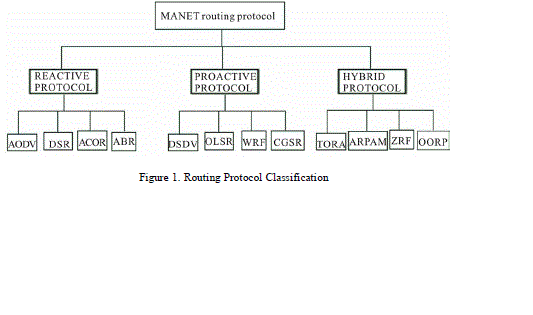 |
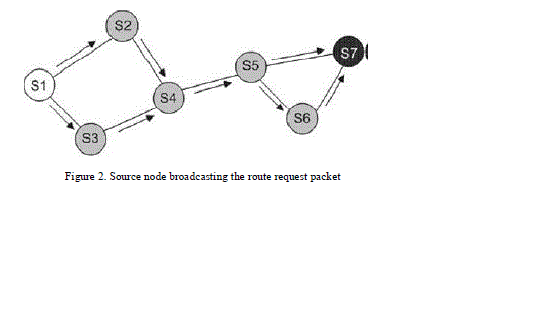 |
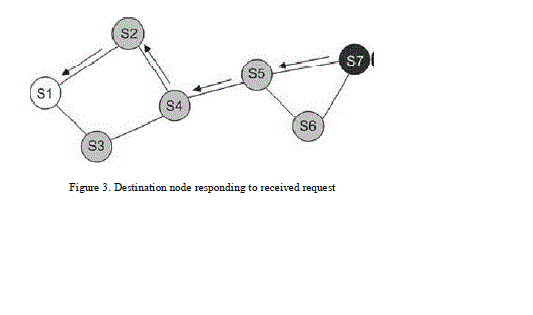 |
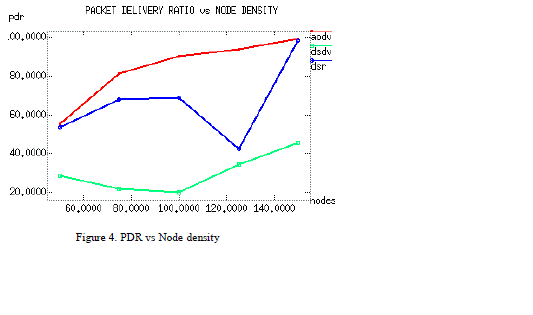 |
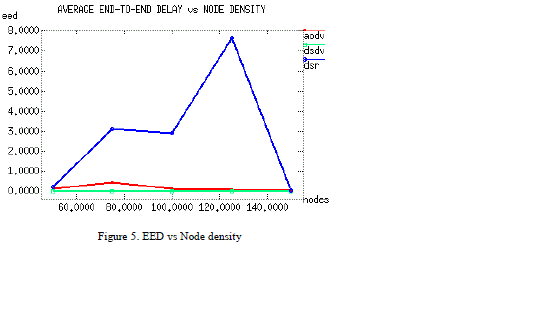 |
| Figure 1 |
Figure 2 |
Figure 3 |
Figure 4 |
Figure 5 |
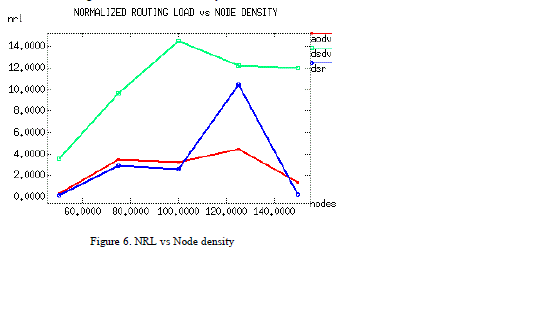 |
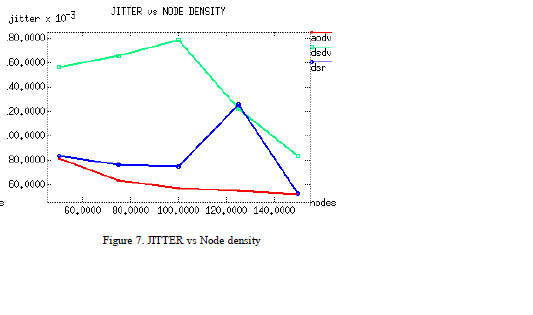 |
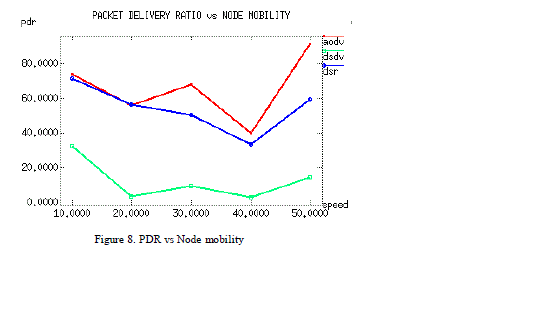 |
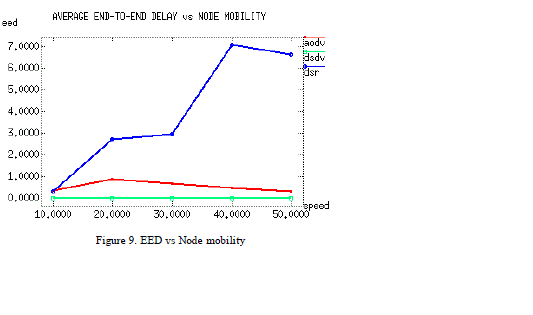 |
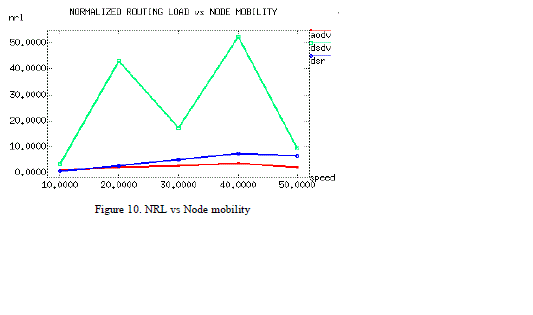 |
| Figure 6 |
Figure 7 |
Figure 8 |
Figure 9 |
Figure 10 |
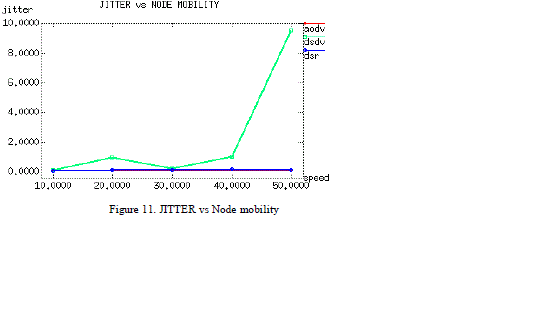 |
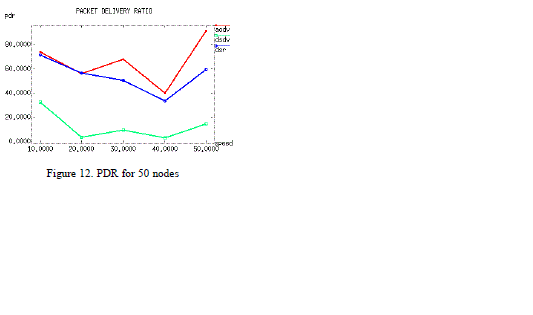 |
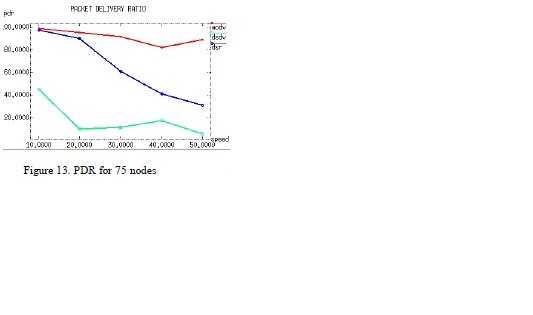 |
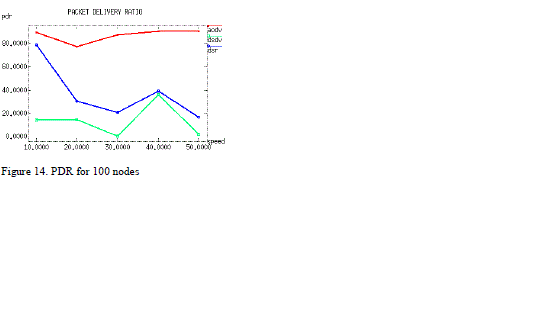 |
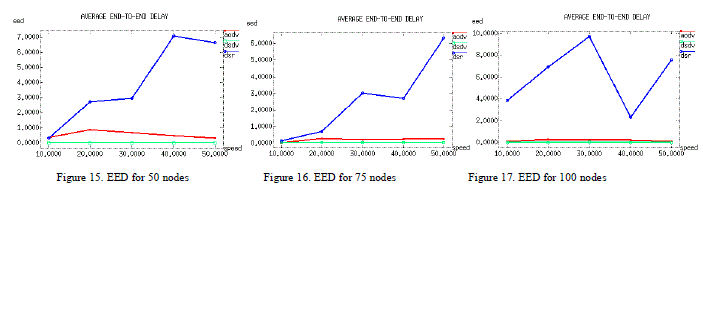 |
| Figure 11 |
Figure 12 |
Figure 13 |
Figure 14 |
Figure 15 |
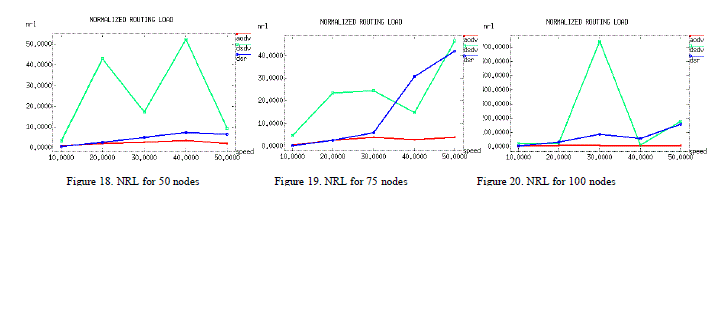 |
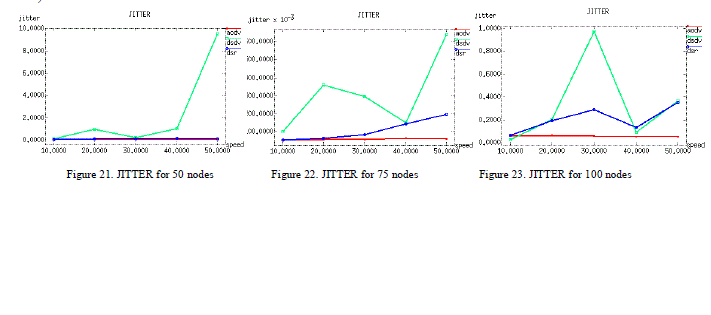 |
| Figure 18 |
Figure 21 |
|
References |
- Sapna S Kaushik, P R Deshmukh, “Comparison of Effectiveness of AODV, DSDV and DSR routing protocols in Mobile Ad hoc Networks”,IJITKM, Vol.2, No.2, July-December.2009.
- Sudip Misra, Issac Woungang, Subhas Chandra Misra, “Guide to Wireless Ad hoc Networks”, Springer, 2009.
- Zuraida Binti Abdullah Hani and Mohd.Dani Bin Baba, “Designing Routing Protocols for Mobile Ad hoc Networks”, IEEE 2003.
- Amith Khandakar, “Step by Step Comparison of DSR, AODV and DSDV Routing Protocol”, ICCET, Vol.40, 2012.
- Akshai Agarwal, Savita Gandhi, Nirbhay Chaubey, “Performance Analysis of AODV, DSDV and DSR in MANETs”, IJDPS, Vol.2, No.6,November 2011.
- Saiful Azadm, Arafatur Rahman, Farhat Anwar, “A Performance Comparison of Proactive and Reactive Routing Protocols of Mobile Ad hocNetworks (MANET)”, Journal of Engineering and Applied Sciences, 2007.
- C. Mbarushimana and A. Shahrabi, “Cooperative study of Reactive and Proactive Routing Protocols for Ad hoc Networks”, AINAW-IEEE,2007.
- Mehran Abolhasan, Tadeusz Wysoci, Eryk Dutkiewicz, “A review of Routing Protocols for Mobile Ad hoc Networks”, ELSEVIER, 2003.
- S. Corson and J. Macker, “Mobile Ad hoc Networking (MANET): Routing Performance Issues and Evaluation Considerations”, University ofMaryland, January 1999.
- Vijendra Rai, “Simulation of Ad-hoc Networks Using DSDV, AODV and DSR Protocols and Their Performance Comparison”, Proceedings ofthe 4th National Conference; INDIACom-2010.
- D. Johnson, “The Dynamic Source Routing Protocol (DSR)”, RFC 4728, February 2007.
- Carlos de Morais Cordeiro, Dharma Prakash Agarwal, “Ad hoc and Sensor Networks”, World Scientific publications, 2006.
- The ns Manual (ns notes and documentation), 2011.
- P Manickam, T Guru Baskar, M Girija, Dr D Manimegalai, “Performance Comparisons of Routing Protocols in Mobile Ad hoc Networks”,IJWMN, Vol.3, No.1, February 2011.
- M A Shabad, Dr S S Apte, “Scenario based Performance Comparison of DSDV, DSR, AODV”, IJARCCE, Vol.2, Issue 8, August 2013.
- C. Perkins, “Ad hoc On-demand Distance Vector (AODV) routing”, RFC 3561, July 2003
- C. E. Perkins and P. Bhagwat, “Highly Dynamic Destination Sequenced Distance-Vector Routing (DSDV) for Mobile Computers”, IGCOMM.London, UK, August 1994.
|